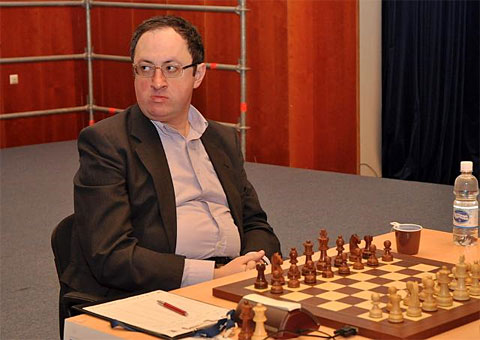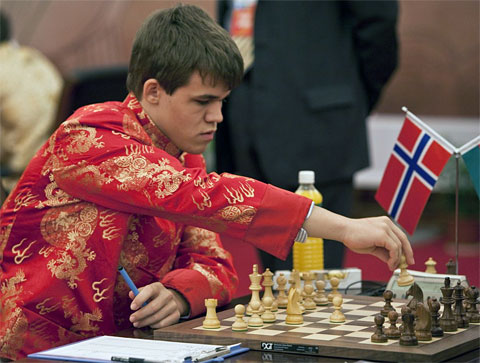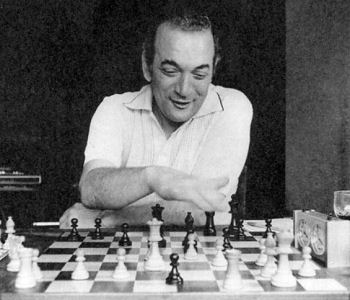| Latest | Greatest | Lobby | Journals | Search | Options | Help | Login |
|
|
|
This topic is archived. |
| Home » Discuss » Topic Forums » Sports |
|
| Jack Rabbit
|
Sun Dec-13-09 02:29 PM Original message |
| The JR Chess Report (December 13): World Cup Final Goes to Tie Break; Magnus Leads in London |
|
World Cup to be Determined by Tie Breaks
 Boris Gelfand and Ruslan Ponomariov drew their final game under standard time control of the final match in 35 moves and will play a series of rapid and blitz games tomorrow to determine the winner of the third bi-annual World Chess Cup in Khanty Mansiysk in central Russia. All four standard games ended in draws. Tomorrow, the players will begin with four rapid games to determine the World Cup winner. If no winner is determined, they will as many as three two-game blitz sets. If no winner is determined after three sets, then an Armageddon game will determine the winner. Magnus Leads London Chess Classic after Five Rounds, Kramnik Second  Magnus Carlsen, who turned 19 on November 30, leads the first ever London Chess Classic after five rounds after defeating Chinese grandmaster Ni Hua earlier today. Using the 3-1-0 scoring system in London, Magnus has 11 points in five games. Former world champion Vladimir Kramnik is in second place with 8 points, after drawing against young British master David Howell in today's round. In other games in London today, Luke McShane with Black defeated US champion Hikaru Nakamura in 55 moves and Mickey Adams battled Nigel Short 43 moves to a draw. Magnus defeated Kramnik in the first round of the event in a game that may have determined first prize early. Kramnik is the last player to take a full point from Magnus in a game played under standard time control. He defeated Magnus in Dortmund on July 10. The seven round tournament ends Tuesday. Calendar This week: Russian National and Women's Championships, Moscow 16-30 December. Other future events: Hastings Chess Congress 26 December 2009-5 January 2010. Rilton Cup, Stockholm 27 December 2009-5 January 2010. Reggio Emilia Tournament 27 December 2009-4 January 2010. Corus Chess Tournament, Wijk aan Zee 15-31 January 2010. Group A: Anand, Carlsen, Caruana, Dominguez, Ivanchuk, Karjakin, Kramnik, Leko, Nakamura, Shirov, Short, Smmets, Tiviakov and van Wely. Gibraltar Chess Festival 26 January-4 February. Moscow Open 29 January-8 February. Aeroflot Open, Moscow 9-17 February. European Individual Championships, Rijeka (Croatia) 5-19 March. Anand-Topalov Match for the World Title, Sofia 23 April-10 May. |
| Printer Friendly | Permalink | | Top |
| Jack Rabbit
|
Sun Dec-13-09 02:36 PM Response to Original message |
| 1. This week's games |
|
Edited on Sun Dec-13-09 02:54 PM by Jack Rabbit
Your humble hare acknowledges the assistance of Fritz 6.0 on analysis. Diagrams on the Jack Rabbit Chess Report are made with Chess Mérida, a true type font that can be downlaoded free here. !""""""""# $tMvWlVmT% $OoOoOoOo% $ + + + +% $+ + + + % $ + + + +% $+ + + + % $pPpPpPpP% $RnBqKbNr% /(((((((() WHITE White to move (This position is a theoretical draw) I would like to thank my impressive and loyal staff: Buccaneer, Spitfire, Swashbuckler, Pancho and Robin Hood. |
| Printer Friendly | Permalink | | Top |
| Jack Rabbit
|
Sun Dec-13-09 02:52 PM Response to Reply #1 |
| 2. World Cup, Semifinal Round, Khanty Manisysk |
| Printer Friendly | Permalink | | Top |
| Jack Rabbit
|
Sun Dec-13-09 03:13 PM Response to Reply #2 |
| 5. Gelfand - Karjakin, Semifinal Round/Game 2 |
 Boris Gelfand Boris Gelfand - Sergey Karjakin Third World Cup, Semifinal Round, Game 2 Khanty Mansiysk, 7 December 2009 Semi-Salv Queen's Gambit: Stoltz Opening 1.d4 Nf6 2.c4 e6 3.Nf3 d5 4.Nc3 c6 5.e3 Nbd7 6.Qc2
6...Bd6 7.Bd3
7...0-0 8.0-0 dxc4 9.Bxc4 b5
10.Be2 Bb7 11.Rd1 Qc7
12.Bd2
12...e5 13.Rac1 a6 14.b4 Rfe8 15.Bd3
15...Bxb4 16.Ng5 h6?
!""""""""# $t+ +t+l+% $+vWm+oO % $o+o+ M O% $+o+ O N % $ V P + +% $+ NbP + % $ +qB PpP% $+ Rr+ K % /(((((((() WHITE: Boris Gelfand Position after 16...h7h6
17.Nxb5!!
17...axb5
18.Bh7+!
18...Kf8
19.Bxb4+
19...c5 20.dxc5 Bc6
21.Be4 Nb8
22.Nh7+ Nxh7 23.Bxh7 g6
24.Rd6!
24...Re7 25.h4 h5
!""""""""# $tM + L +% $+ W To+b% $ +vR +o+% $+oP O +o% $ B + + P% $+ + P + % $p+q+ Pp+% $+ R + K % /(((((((() WHITE: Boris Gelfand Position after 25...h6h5 26.Bxg6!!
26...fxg6 27.Qxg6 Rxa2
28.Rcd1 Rf7 29.Qh6+ Rg7 30.Qf6+ Kg8
31.Rd8+ Kh7 32.Qf5+ Rg6 33.Qxh5+ Rh6 34.Qf5+ 1-0
|
| Printer Friendly | Permalink | | Top |
| Jack Rabbit
|
Sun Dec-13-09 03:16 PM Response to Reply #2 |
| 6. Malakhov - Ponomariov, Semifinal Round Tie Break, Rapid Game 4 |
 Ruslan Ponomariov Vladimir Malakhov - Ruslan Ponomariov Third World Cup, Semifinal Round Tie Break, Rapid Game 4 Khanty Mansiysk, 8 December 2009 East Inia Game: Nimzo-Indian Defense (Capablanca Opening/Noa Variation) 1.d4 Nf6 2.c4 e6 3.Nc3 Bb4 4.Qc2 d5
5.cxd5 exd5
6.Bg5
6...c5
7.Nf3
7...h6
8.Bh4!?
8...g5
9.Bg3 Ne4 10.e3
10...Bf5 11.Bd3 c4 12.Bxe4
12...Bxe4 13.Qa4+ Nc6 14.Ne5?!
!""""""""# $t+ Wl+ T% $Oo+ +o+ % $ +m+ + O% $+ +oN O % $qVoPv+ +% $+ N P + % $ + + PpP% $R + K +r% /(((((((() WHITE: Vladimir Malakhov Position after 14.Nf3e5 14...Bxg2!
15.Nxc6 Bxc3+ 16.bxc3 Qd7 17.Rg1
17...Be4 18.Be5 Rg8 19.f3 Bd3 20.e4?
!""""""""# $t+ +l+t+% $Oo+ +o+ % $ +w+ + O% $+ +o+ O % $q+oPp+ +% $+ P +p+ % $p+ + + P% $R + K R % /(((((((() WHITE: Vladimir Malakhov Position after 20.e3e4 20...Qxc6!
21.Qa5 dxe4 22.Kf2
22...f6 23.Bg3 b6
24.Qb4 e3+ 25.Ke1 Qxf3 0-1
|
| Printer Friendly | Permalink | | Top |
| Jack Rabbit
|
Sun Dec-13-09 03:17 PM Response to Reply #2 |
| 7. Karjakin - Gelfand, Semifinal Round/Game 1 |
 Boris Gelfand Sergey Karjakin - Boris Gelfand Third World Cup, Semifinal Round, Game 1 Khanty Mansiysk, 6 December 2009 Italian Royal Game: Clam Opening/Gothic Defense (Two Knights' Defense) 1.e4 e5 2.Bc4 Nf6 3.d3 Nc6 4.Nf3 Be7 5.0-0 0-0 6.Bb3
6...d5
7.exd5
7...Nxd5 8.h3
8...a5 9.a4
9...Nd4
10.Nxd4!?
10...exd4
11.Re1 Ra6!?
12.Qh5!?
12...Nb4!?
13.Na3!
13...Rg6
14.Bf4 b6 15.Qf3 Be6 16.Bxe6!?
16...fxe6 17.Qe4
17...Bd6
18.Bxd6?
!""""""""# $ + W Tl+% $+ O + Oo% $ O Bo+t+% $O + + + % $pM Oq+ +% $M +p+ +p% $ Pp+ Pp+% $R + R K % /(((((((() WHITE: Sergey Karjakin Position after 18.Bf4d6:B 18...cxd6!!
19.Qxd4 Qg5!
20.g3 Qf5 21.g4
21...h5 22.Re4
22...d5 23.Kh2
23...Qf3 24.Ree1
!""""""""# $ + + Tl+% $+ + + O % $ O +o+t+% $O +o+ +o% $pM Q +p+% $N +p+w+p% $ Pp+ P K% $R + R + % /(((((((() WHITE: Sergey Karjakin Position after 24.Re4e1 24...hxg4 25.Qe3
25...gxh3!
26.Qxf3 Rxf3 27.Rg1
27...Rxf2+ 28.Kxh3 Rxg1 29.Rxg1 Nxc2 30.Nb5
30...Rf3+ 31.Kg4 Rxd3
32.Nd6 Ne3+ 33.Kf4 Nc4 0-1
|
| Printer Friendly | Permalink | | Top |
| Jack Rabbit
|
Sun Dec-13-09 02:55 PM Response to Reply #1 |
| 3. London Chess Classic |
| Printer Friendly | Permalink | | Top |
| Jack Rabbit
|
Sun Dec-13-09 03:19 PM Response to Reply #3 |
| 8. Carlsen - Kramnik, Round 1 |
 Magnus Carlsen Magnus Carlsen - Vladimir Kramnik Chess Classic, Round 1 London, 8 December 2009 King's Englsih Game: Four Knights' Opening (Catalan Variation) 1.c4 Nf6 2.Nc3 e5 3.Nf3 Nc6 4.g3 d5 5.cxd5 Nxd5 6.Bg2 Nb6 7.0-0 Be7 8.a3 0-0
9.b4 Be6 10.Rb1 f6 11.d3 a5
12.b5 Nd4 13.Nd2 Qc8
14.e3 Nf5 15.Qc2 Rd8 16.Bb2 a4
17.Rfc1!?
!""""""""# $t+wT +l+% $+oO V Oo% $ M +vO +% $+p+ Om+ % $o+ + + +% $P NpP P % $ BqN PbP% $+rR + K % /(((((((() WHITE: Magnus Carlsen Position after 17.Rf1c1 17...Nd6
18.Nde4 Ne8 19.Qe2 Bf8
20.f4
20...exf4 21.gxf4 Qd7
22.d4 c6!?
!""""""""# $t+ TmVl+% $+o+w+ Oo% $ Mo+vO +% $+p+ + + % $o+ PnP +% $P N P + % $ B +q+bP% $+rR + K % /(((((((() WHITE: Magnus Carlsen Position after 22...c7c6 23.Nc5!
23...Bxc5 24.dxc5 Nc4
25.Rd1
25...Qc7
26.Bc1
26...Na5
27.bxc6 bxc6 28.Nxa4 Rxd1+ 29.Qxd1
29...Rd8 30.Qc2 Qf7
31.Nc3!?
31...Qh5!
32.Ne2 Bf5?
!""""""""# $ + Tm+l+% $+ + + Oo% $ +o+ O +% $M P +v+w% $ + + P +% $P + P + % $ +q+n+bP% $+rB + K % /(((((((() WHITE: Magnus Carlsen Position after 32...Be6f5 33.e4!
33...Bg4 34.Ng3 Qf7 35.Bf1
35...Be6 36.Qc3 Ra8
37.Rb4 Qd7
38.f5 Bf7 39.Bf4 Qd1 40.Kf2 Nb3
41.Be2 Qb1
!""""""""# $t+ +m+l+% $+ + +vOo% $ +o+ O +% $+ P +p+ % $ R +pB +% $PmQ + B % $ + +bK P% $+w+ + + % /(((((((() WHITE: Magnus Carlsen Position after 41...Qd1b1 42.Bc4!
42...Rxa3 43.Ne2 1-0
|
| Printer Friendly | Permalink | | Top |
| Jack Rabbit
|
Sun Dec-13-09 03:20 PM Response to Reply #3 |
| 9. McShane - Kramnik, Round 3 |
 Vladimir Kramnik Luke McShane - Vladimir Kramnik Chess Classic, Round 3 London, 10 December 2009 Italian Horseman Game: Clam Opening 1.e4 e5 2.Bc4
2...Nf6 3.d3 Bc5
4.Nf3 0-0
5.Nc3!?
5...d6
6.Na4 Bb6 7.c3 Be6 8.Bb3 Bxb3 9.axb3 Nbd7 10.b4!?
10...Bxf2+!
11.Kxf2 b5
12.Bd2 bxa4 13.Qxa4
13...c5
14.b5 d5 15.exd5 Nb6 16.Qc2 c4
17.Nxe5!
17...Qxd5 18.d4!?
!""""""""# $t+ + Tl+% $O + +oOo% $ M + M +% $+p+wN + % $ +oP + +% $+ P + + % $ PqB KpP% $R + + +r% /(((((((() WHITE: Luke McShane Position after 18.d3d4 18...Ne4+!
19.Kg1 Rfe8 20.Nf3
20...Qxb5 21.h4 Qb3!?
22.Qb1!?
22...Nd5!
23.Rh3 h6 24.Qc1 Qb6 25.Ra4?
!""""""""# $t+ +t+l+% $O + +oO % $ W + + O% $+ +m+ + % $r+oPm+ P% $+ P +n+r% $ P B +p+% $+ Q + K % /(((((((() WHITE: Luke McShane Position after 25.Ra1a4 25...Rab8!
26.Ra2
26...Qb3
27.Qa1
27...Rb6 28.Kh2
28...Ndf6 29.Be1
29...Ng4+ 30.Kg1 Nef6
31.d5
31...Nxd5 32.Rg3 Ndf6 33.Bd2
33...Rd6 34.Ra3 Qb6+ 35.Kh1 Nf2+ 36.Kh2 N6g4+ 0-1
|
| Printer Friendly | Permalink | | Top |
| Jack Rabbit
|
Sun Dec-13-09 02:58 PM Response to Reply #1 |
| 4. Bonus Game: Korchnoi - Karpov, Baguio City, 1978 |
 Viktor Korchnoi shortly after defecting to the West, Summer 1976 Viktor Korchnoi - Anatoly Karpov Match for the World Title, Round 31 Baguio City, The Philippines, 12 October 1978 Orthodox Queen's Gambit: Exchange Opening 1.c4 e6 2.Nc3 d5 3.d4 Nf6
4.cxd5
4...exd5 5.Bg5
5...Be7
6.e3 0-0
7.Bd3 Nbd7 8.Nf3 Re8 9.Qc2 c6 10.0-0 Nf8 11.Bxf6
11...Bxf6 12.b4 Bg4
13.Nd2 Rc8 14.Bf5
14...Bxf5 15.Qxf5 Qd7!?
16.Qxd7 Nxd7 !""""""""# $ +t+t+l+% $Oo+m+oOo% $ +o+ V +% $+ +o+ + % $ P P + +% $+ N P + % $p+ N PpP% $R + +rK % /(((((((() WHITE: Viktor Korchnoi Position after 16...Nf8d7:Q
17.a4 Be7 18.Rfb1
18...Nf6 19.a5 a6
20.Na4 Bf8 21.Nc5 Re7 22.Kf1
22...Ne8 23.Ke2 Nd6 24.Kd3 Rce8 25.Re1
25...g6
26.Re2 f6!?
27.Rae1 Bh6
28.Ndb3!
28...Bf8
!""""""""# $ + +tVl+% $+o+ T +o% $o+o+ Oo+% $P No+ + % $ P P + +% $+n+kP + % $ + +rPpP% $+ + R + % /(((((((() WHITE: Viktor Korchnoi Position after 28...Bh6f8 29.Nd2!?
29...Bh6 30.h3 Kf7 31.g4 Bf8
32.f3 Rd8 33.Ndb3
33...Nb5 34.Rf1 Bh6 !""""""""# $ + T + +% $+o+ Tl+o% $o+o+ OoV% $PmNo+ + % $ P P Pp+% $+n+kP +p% $ + +r+ +% $+ + +r+ % /(((((((() WHITE: Viktor Korchnoi Position after 35...Bf8h6 35.f4!?
35...Bf8 36.Nd2 Nd6
37.Rfe1 h6
38.Rf1 Rb8 39.Ra1 Rbe8 40.Rae1 Rb8!?
!""""""""# $ T + V +% $+o+ Tl+ % $o+oM OoO% $P No+ + % $ P P Pp+% $+ +kP +p% $ + Nr+ +% $+ + R + % /(((((((() WHITE: Viktor Korchnoi Position after 40...Re8b8 41.e4
41...dxe4+ 42.Ndxe4 Nb5
43.Nc3
43...Rxe2 44.Rxe2 Bxc5 45.bxc5 Rd8 46.Nxb5 axb5 47.f5
47...gxf5
48.gxf5 Rg8 49.Kc3!?
49...Re8 50.Rd2!?
!""""""""# $ + +t+ +% $+o+ +l+ % $ +o+ O O% $PoP +p+ % $ + P + +% $+ K + +p% $ + R + +% $+ + + + % /(((((((() WHITE: Viktor Korchnoi Position after 50.Re2d2 50...Re4!
51.Kb4!? Ke8 52.a6!
52...bxa6 53.Ka5 Kd7 54.Kb6 b4 55.d5
55...cxd5 56.Rxd5+ Kc8 57.Rd3 a5
58.Rg3!
58...b3
59.Kc6
59...Kb8?
!""""""""# $ L + + +% $+ + + + % $ +k+ O O% $O P +p+ % $ + +t+ +% $+o+ + Rp% $ + + + +% $+ + + + % /(((((((() WHITE: Viktor Korchnoi Position after 59...Kc8b8 60.Rxb3+!
60...Ka7
61.Rb7+ Ka6 62.Rb6+ Ka7 63.Kb5!
63...a4 64.Rxf6 Rf4 65.Rxh6 a3
66.Ra6+ Kb8 67.Rxa3 Rxf5
68.Rg3 Rf6 69.Rg8+ Kc7 70.Rg7+ Kc8 71.Rh7 1-0
|
| Printer Friendly | Permalink | | Top |
| Jack Rabbit
|
Mon Dec-14-09 02:20 PM Response to Original message |
| 10. Update (Monday morning PST): Gelfand Wins World Cup |
 Israeli grandmaster Boris Gelfand won the world Chess Cup today in the central Russian oil boom town of Khanty Mansiysk when he defeated GM Ruslan Ponomariov of Ukraine in the fourth of a possible six blitz games in the final round tie break. In contrast to the standard time control games of the previous four days, where all games ended in draws, today's playoff rounds were marked by a series of decisive games. Each player won one and drew two of the rapid games, sending the final match to a series of two-game blitz sets. Gelfand and Ponomariov exchanged victories in the first set, but then Gelfand won both games in the second set to end the third bi-annual World Cup.  From today's action in Khanty Mansiysk with the World Cup in the foreground Magnus Holds Lead in London Classic, Kramnik in Striking Distance  Nineteen-year-old Norwegian grandmaster Magnus Carlsen drew his sixth round game with British GM Mickey Adams in the London Chess Classic today to hold on to sole possession of first place while former world champion Vladimir Kramnik of Russia defeated former championship challenger Nigel Short of Britain to move within striking distance of Magnus with one round remaining to play. Using the football-style 3-1-0 scoring system, Magnus leads Kramnik in the tournament standings, 12-11. Kramnik will need a win tomorrow when he plays Black against reigning US champion Hikaru Nakamura tomorrow and hope that Magnus comes up short in his final game against Short. |
| Printer Friendly | Permalink | | Top |
| Jack Rabbit
|
Tue Dec-15-09 03:44 PM Response to Original message |
| 11. Update (Tuesday Noon PST): Magnus Takes London Classic |
 Norwegian grandmaster Magnus Carlsen, at 19 currently the world's strongest player, won the first London Chess Classic today when he drew his game in the seventh and final round with British GM and former world championship challenger Nigel Short in 71 moves while former world champion Vladimir Kramnik of Russia drew his last game with reigning American national champion Hikaru Nakamura. Vladimir Borisovich was the only other player with a chance to overtake Magnus. However, he needed a win to do so. Magnus has been taking training from former world champion Garry Kasparov, consider by many, including by your humble hare, to be the greatest player of all time. This Autumn, since the announcement about the collaboration with Kasparov was made, Magnus has not lost a single standard time control game. Magnus finished first in the Nanjing Grand Prix in October and second in the Tal Memorial Tournament in Moscow in November, where he suffered from a fever as the event began. Magnus also won the the World Blitz Championship that followed the Tal Memorial in Moscow and finished second in another strong blitz tournament in Oslo in early December. When FIDE releases its official ratings next month, Magnus will top the list with an Elo score in excess of 2810. Many chess observers picked Magnus as a future world champion when he became a grandmaster at the age of 13. It now looks like the question is not whether Magnus will be world champion in the future, but whether or not he will become the dominant player of his generation, as Kasparov was to his. |
| Printer Friendly | Permalink | | Top |
| DU
AdBot (1000+ posts) |
Thu Apr 25th 2024, 07:12 AM Response to Original message |
| Advertisements [?] |
| Top |
| Home » Discuss » Topic Forums » Sports |
|
Powered by DCForum+ Version 1.1 Copyright 1997-2002 DCScripts.com
Software has been extensively modified by the DU administrators
Important Notices: By participating on this discussion board, visitors agree to abide by the rules outlined on our Rules page. Messages posted on the Democratic Underground Discussion Forums are the opinions of the individuals who post them, and do not necessarily represent the opinions of Democratic Underground, LLC.
Home | Discussion Forums | Journals | Store | Donate
About DU | Contact Us | Privacy Policy
Got a message for Democratic Underground? Click here to send us a message.
© 2001 - 2011 Democratic Underground, LLC